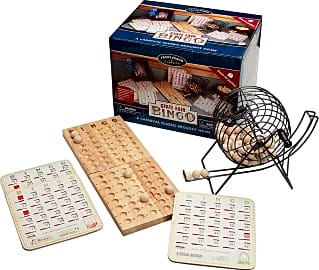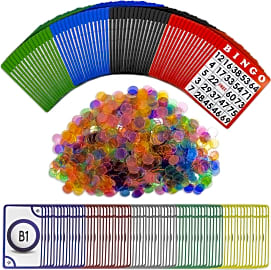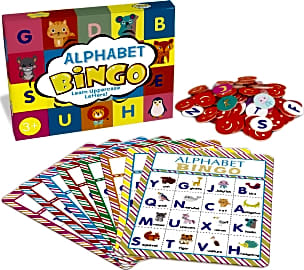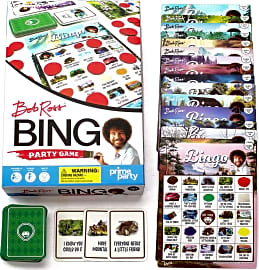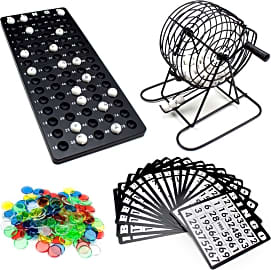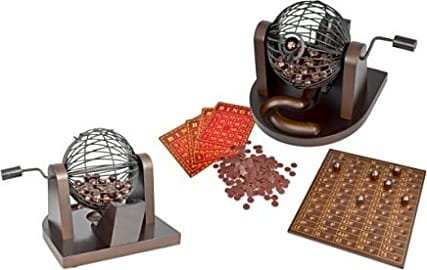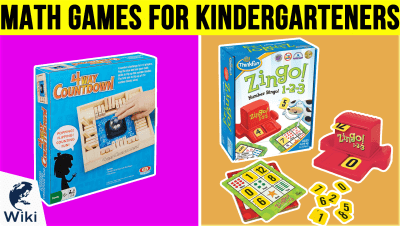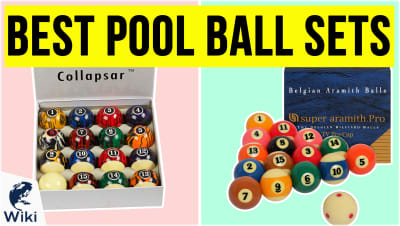The 10 Best Bingo Sets

This wiki has been updated 35 times since it was first published in April of 2016. If you're looking for an entertaining activity for a fundraiser, a nursing home event, or an evening of quality family time, you can't go wrong with the classic game of bingo. You’ll find a variety of choices in our selection, including sets that are suitable for both adults and children, as well as ones that can help teach kids math and spelling in a fun and engaging way. When users buy our independently chosen editorial recommendations, we may earn commissions to help fund the Wiki.
Editor's Notes
June 24, 2020:
These bingo sets come a wide range of designs, so there’s something for everyone, whether you’re looking for a traditional-style game with a cage spinner and chips, like the Royal Bingo Supplies GBIN-103 or the Front Porch Classics State Fair, as well as fun educational games for children, like the Trend Enterprises Multiplication & Division. Today we added in the Deeplay Alphabet, another set for kids that’s designed to teach letter recognition and improve concentration and memory. Included are eight double-sided scorecards, and each square is decorated with a colorful cartoon animal and the corresponding letter it begins with. Everything is laminated, so you don’t have to worry too much about heavy-duty handling by rambunctious youngsters.
We also added in the Mr Chips All-in-One, an option that’s great for some serious hardcore games at the local hall or a senior center. This heavy-gauge steel table-top model features a spacious tumbler that ensures the balls are shuffled well every time, and it’s equipped with a bright red acrylic handle that’s comfortable to use. The colorful balls are printed with large, clear numbers, so the caller won’t have any problem deciphering them. When the game is done, simply flip the switch to get the balls to return quickly to the cage. Fans of the iconic painter who hosted the TV program “The Joy of Painting” are sure to enjoy the newly added Prime Party Bob Ross set. Each scorecard features a different painting by the artist, and the calling cards and matching squares are printed with some of his noteworthy quotes.
If you don’t want to be bothered with a bulky cage, balls, and a large calling board, look to the Royal Bingo Supplies Bundle, which uses a deck of 75 calling cards with large alphanumeric characters. It’s compact and easy to pack up to take to your destination, yet can accommodate a large gathering of up to 100 participants at a time. On a safety-related note, be aware many of these sets are not suitable for children younger than age three, since they contain small parts. Be sure to abide by the manufacturer’s age requirements for any given set.
Special Honors
US-Bingo Digital Bingo Flashboard System This high-tech system incorporates a 50-inch flat-screen display along with a touchscreen panel for selecting the numbers manually. It’s for use in conjunction with a bingo cage or blower. The 20-inch control panel displays exactly what is on the flatscreen. As a caller, once you’ve determined your next number, simply select that number on the touchscreen, and it will display for all of the players to see. It’s large enough that even those in the back of the hall can see it easily. It comes with a 15-foot HDMI cable, and the option to upgrade to a larger flat-screen is also available. us-bingo.com
Professional Table Top Bingo Blower Machine Easy to use and featuring fun LED lights, this electronic machine is great for bingo halls, senior centers, retirement homes, and fundraisers. Its blower mixes the balls and sends a random one for you to call each time. Once one is sent out, simply place it on the large master board that’s situated on top of the machine. The large characters on the balls make them easy for anyone to read. When the game is done, just lift the tray and the balls drop back down into the blower. Included with this set is a one-year warranty that covers parts. casinosupply.com
A Brief History Of Bingo
It then fell into the public domain, and imitators took its success and ran with it.
You might think that old ladies screaming at each other every week is something that dates back to time immemorial, but bingo — or its predecessors, anyway — is only a few hundred years old.
Its origins date back to Italy in the year 1530, when the country's national lottery was organized. It involved players using cards with numbered squares on them, and corresponding numbers being drawn out of a sack — sound familiar?
The game was played regionally over the next few centuries, and an American named Hugh J. Ward started taking the game around carnivals in the Pittsburgh area in the early 1920s. He even went so far to copyright it and publish a rulebook, but he never got rich off of it. As a result, a toy salesman named Edwin S. Lowe took the game — now called "Beano" — and mass-produced it in New York.
How "Beano" ended up as "Bingo" is a bit of a mystery, but it's believed that it resulted from an over-eager winner getting the name wrong. Regardless, it stuck, and the name Beano is now reserved for gas pain products.
Lowe made a good chunk of change off of his game, but he made one mistake that cost him millions: he never trademarked it. It then fell into the public domain, and imitators took its success and ran with it. However, Lowe wasn't done altering the future of the game quite yet. Gambling on it was extremely popular, and Lowe was approached by someone who wanted a cut of the action: a priest from Wilkes-Barre, Pennsylvania.
The holy man had a parish that was in financial trouble, and he recognized the fundraising potential of the game. There was only one problem, though, and that was that the games tended to have multiple winners.
Lowe sought out a math professor from Columbia named Carl Leffler, who created cards with non-repeating number groups. Once Leffler completed the project, the game spread like wildfire among churches and other charitable groups. In many states with anti-gambling laws, bingo was exempted, so many people were able to get their fix at weekly games held in parishes and nursing homes.
Today, bingo is one of the most lucrative games on the planet, and it could be said that enough is spent on it per week in North America to run a small country. Everyone from kids to senior citizens can play, and only one thing remains constant: Granny will absolutely cut you if you call out "bingo" before she does.
How To Run Your Own Bingo Game
If you're hoping to get your own game up and running, whether to raise money or just to have some fun, there are some things you should know that will help you see to it that everything goes smoothly.
If you're trying to use bingo as a fundraiser, you should probably check with your local authorities to make sure that it's kosher before you begin. After all, nothing can shut down a PTA event quite like getting raided by the local SWAT team. Some jurisdictions require you to get permits, while others only allow players to win prizes rather than money.
Some jurisdictions require you to get permits, while others only allow players to win prizes rather than money.
Also, be sure to advertise ahead of time. Send out fliers or post signs at least two weeks before the big night, and make sure that it doesn't coincide with any holidays or other special events.
If you have to give out prizes in lieu of cash, try to find some gifts that people will be excited to win. Don't dampen someone's big moment by handing them something lame, like a used VCR or something (unless that's part of the fun and the crowd knows it ahead of time).
While you have people in one place and in the mood to gamble, it's a good idea to run other games at the same time. Have someone sell raffle tickets or pull tabs, and kill two birds with one stone (but definitely check your local laws regarding the pull tabs, as they're more heavily regulated than bingo). Running a concession stand is also a smart idea.
If you take a little time and do your prep work, your game night should be a smashing success. And if you don't, well...there will be lots of little old ladies who are eager to smash you.
Tips To Boost Your Chances Of Winning
While bingo is a game of chance, that doesn't mean that there aren't things you can do to boost your odds of winning.
The first thing you can do is obvious: play at a time when there are fewer players, and buy more tickets. If you have more cards than anyone else, you'll have a better chance of winning — provided you can keep up with them all, of course.
Beyond that, there are more advanced — some might even say fanatical — strategies you can employ.
Another option is the Tippett strategy, which was conceived by a British statistician who had nothing better to do than to try to cheat at bingo.
One is known as Granville's strategy, and it originates in the stock market. The idea is that, over time, there will be a relatively even balance of odd and even numbers called, as well as an equal amount of high and low numbers picked. Thus, you should aim to have an equal mix of high and low numbers, as well as even and odd. Furthermore, you should aspire to not have too many numbers that end in the same digit.
Another option is the Tippett strategy, which was conceived by a British statistician who had nothing better to do than to try to cheat at bingo. His theory is that, the longer the game is, the more likely it is that numbers will have a median number of 38, so you should try to get cards in that number range. Conversely, in shorter games, you should stick to digits closer to 1 or 75.
Ultimately, though, the most effective strategy will likely be to talk to your fellow players as much as possible, in the hopes that it will distract them and force them to miss a bingo.
Hey, we never said we played fair.



